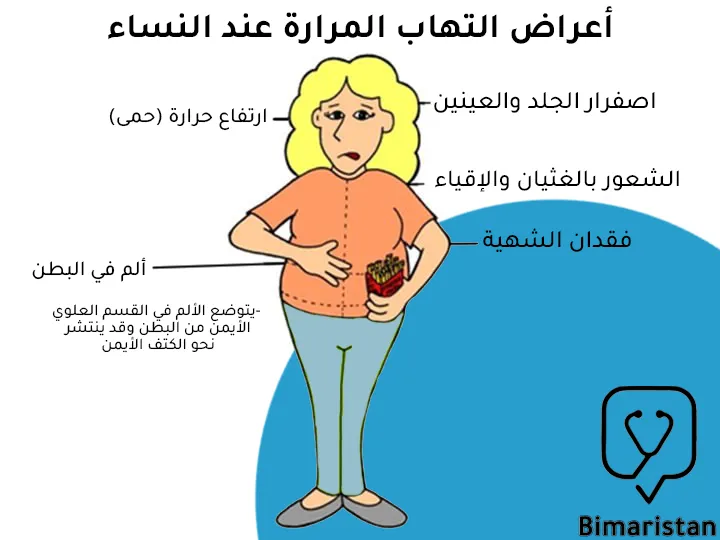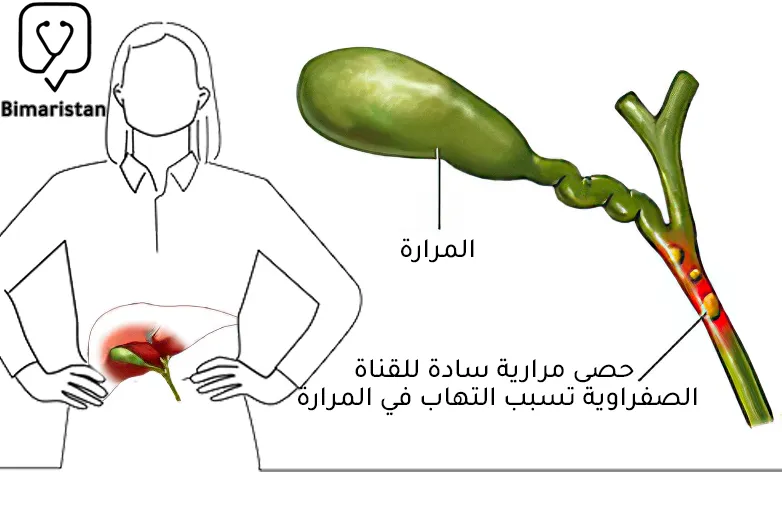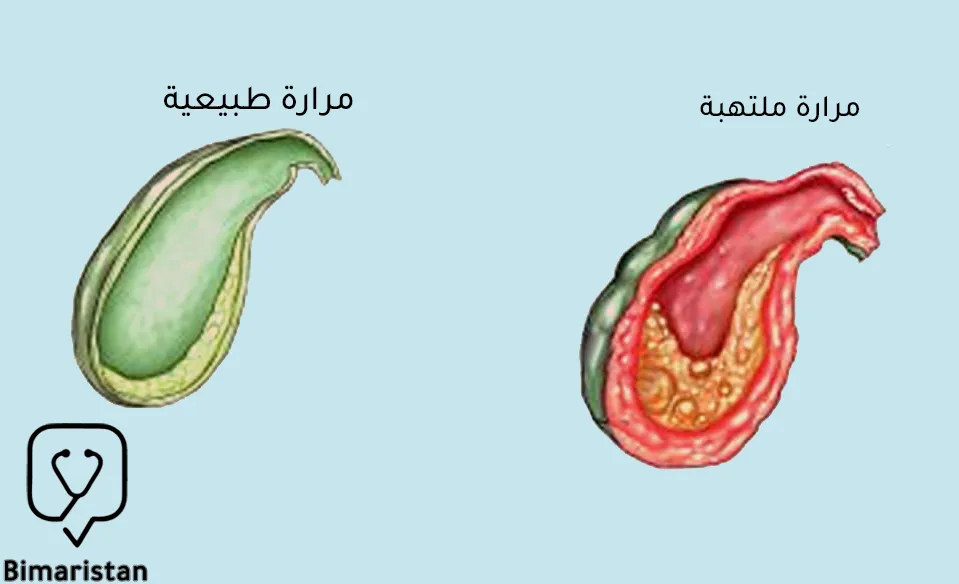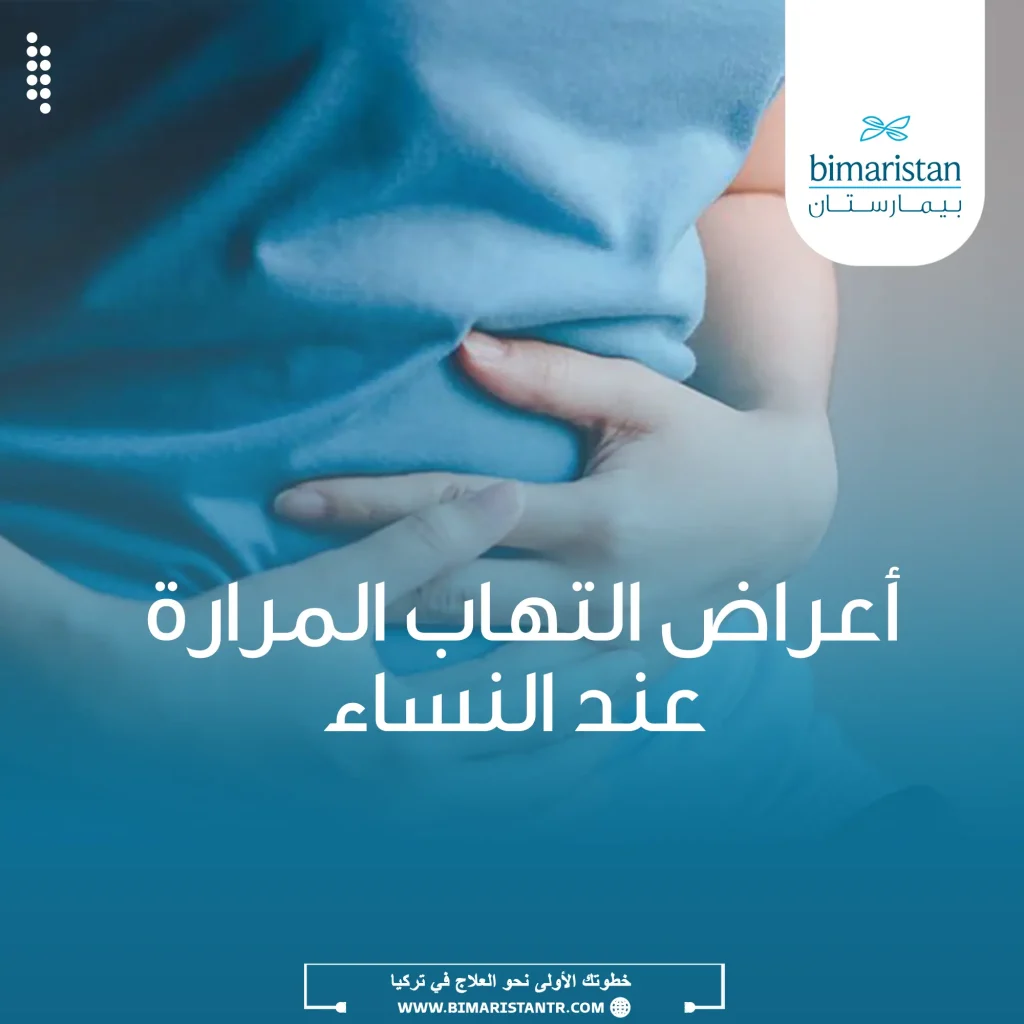أعراض التهاب المرارة عند النساء لا تختلف كثيراً عما هي عليه عند الرجال، إذ يعتبر ألم البطن العلوي المتوضع في القسم الأيمن من اشيع اعراض المرارة الملتهبة للنساء.
لا تقتصر أعراض المرارة على الألم فحسب، إذ عادةً ما يترافق الالتهاب مع العديد من الأعراض الهضمية المزعجة والتي تستغرق غالبًا فترة يومين إلى ثلاثة أيام وتظهر بشكل حاد ومفاجئ بدون سابق إنذار.
المرارة هي عبارة عن عضو صغير الحجم يقع أسفل الكبد مباشرةً، تقوم المراره بوظيفة تخزين عصارة الصفراء التي ينتجها الكبد لحين تصريفها لاحقاً عبر مجرى القناة الصفراوية المتصل بالمرارة والذي يصب في الأمعاء، ولكن هذه القناة قد تتعرض للانسداد مما يسبب تجمع الصفراء داخل المرارة وحدوث التهاب مراري، إذ تعتبر حصوات المراره السادة من أهم أسباب ظهور أعراض المرارة عند النساء.
ما هي أعراض التهاب المرارة عند النساء؟
النساء هم أكثر عرضة للإصابة بالتهاب المرارة من الرجال، يعزى سبب ذلك لتأثير الهرمونات الأنثوية وتحديداً هرمون الإستروجين في زيادة إفراز الكولسترول والذي يساهم بدوره في تشكيل الحصى المرارية المسببة للالتهاب.
على الرغم من أن ألم البطن الحاد هو من أهم أعراض المرارة وأشيعها إلا أن الكثير من أمراض الجهاز الهضمي قد تسبب آلام مشابهة في البطن، فليس كل ألم بطني يشير بالضرورة إلى التهاب في المرارة، فقد تكون المشكلة بالكبد أو في الزائدة أو حتى في القولون والأمعاء.
من المهم أن تكون السيدة على علم بأعراض التهاب المرارة لبدء علاج الحالة بأسرع وقت ممكن خوفاً من تطور مضاعفات خطيرة للالتهاب كتمزق المرارة والذي يشكل تهديداً على حياة المريضة، فمن أعراض المرارة عند النساء ما يلي:
- ألم شديد وحاد في الجزء العلوي الأيمن من البطن
- قد يمتد ألم البطن باتجاه الكتف الأيمن وتزداد شدته عند لمس البطن وضغطه
- الشعور بالغثيان والرغبة في الإقياء
- ارتفاع الحرارة (الحمى)
- فقدان الشهية
- التعرق الشديد
- تسارع التنفس
- اصفرار في الجلد والعينين (يرقان)
في حال شعرتِ بأحد هذه العلامات فمن الأفضل مراجعة الطبيب على الفور لكشف السبب وراء هذه الاعراض والتي من المحتمل أن تكون عائدة لالتهاب المرارة الحاد.
أعراض المرارة المبكرة
أعراض المرارة المبكرة تشمل مجموعة من العلامات التي يمكن أن تشير إلى ضعف أو مشكلات في المرارة:
- الألم الصفراوي: غالبًا ما يكون الألم هو أول عرض لمشاكل المرارة ويظهر عادة كألم متقطع في الجزء العلوي الأيمن من البطن بالقرب من القفص الصدري. يمكن أن يزداد هذا الألم بشكل حاد ويمتد إلى أعلى الظهر، ويعرف أيضًا باسم “المغص الصفراوي”.
- الغثيان أو القيء: يمكن أن يرافق الألم في المرارة الغثيان أو القيء، ويعتبران علامة على وجود مشاكل أو اضطرابات في المرارة.
- الحمّى أو القشعريرة: قد تؤدي المشكلات المرتبطة بالمرارة مثل العدوى إلى ظهور حمّى غير مبررة أو الشعور بالقشعريرة، وهذا قد يكون علامة على حالة خطيرة تتطلب علاجًا فوريًا.
- الإسهال المزمن: قد يكون حدوث حركة أمعاء كثيرة خلال النهار علامة على مشكلات في المرارة، وإذا استمر هذا الإسهال لفترة طويلة قد يكون مؤشرًا على وجود مشكلة كبيرة مثل مرض المرارة المزمن.
- اليرقان: يُعد اليرقان، وهو اصفرار الجلد، علامة على وجود تجمعات أو حصى في القناة الصفراوية، وهو مؤشر على تداعيات خطيرة يجب التحقق منها والعلاج الفوري.

أعراض التهاب المرارة عند النساء الحوامل
الحامل معرضة بشكل أكبر للإصابة بالتهاب المرارة نتيجة تأثير التغيرات الهرمونية التي تطرأ على جسم الأنثى خلال فترة الحمل والتي تحرض تشكل الحصى في المرارة لزيادة الكوليسترول.
8% من الحوامل سوف تتشكل لديهم حصى مرارية جديدة في الثلث الأخير من الحمل، ولكن لا تصاب جميع هذه الحالات بالتهاب المرارة بل يقتصر الالتهاب على 1% فقط من هؤلاء النسوة نتيجة انسداد قناة الصفراء بأحد الحصوات المرارية مما يؤدي لظهور أعراض التهاب المرارة.
عادةً ما تتشابه أعراض المرارة عند الحامل مع الأعراض النموذجية التي تظهر لدى عامة السيدات، لكن قد تختلط في بعض الأحيان اعراض الحمل الطبيعية (الغثيان والإقياء) مع أعراض الالتهاب المراري مما يؤدي إلى التأخر في وضع التشخيص والبدء بالمعالجة، بالإضافة إلى أن طريقة العلاج تختلف لدى الحامل عن السيدات الأخريات.
عند شعور الحامل بألم حاد في أعلى البطن من الجهة اليمنى مع حمى وغثيان أو إقياء فمن الأفضل لها استشارة طبيبها أبكر ما يمكن.
أسباب التهاب المرارة عند النساء
كما ذكرنا سابقًا فإن المرارة تعمل على تخزين الصفراء المفرزة من الكبد حتى يتم طرحها إلى الأمعاء عبر الأقنية الصفراوية، تصاب المرارة بالالتهاب في حال بقاء الصفراء داخل نسيج المراره لوجود عائق انسدادي يمنع مغادرة السائل الصفراوي مما يتسبب بتخريش جدار المرارة، هذه العوائق تشمل ما يلي:
حصى المرارة
تعتبر الحصى من أهم وأشيع الأسباب المؤدية لالتهاب المرارة، فعندما تتكون حصوة كبيرة الحجم وتنزلق لتسد مجرى قناة الصفراء يبدأ عندها الشعور بِألم في القسم العلوي البطن وتتطور أعراض التهاب المرارة الأخرى مع مرور الوقت.
ليس بالضرورة أن تؤدي جميع حصوات المرارة لحدوث التهاب مراري فقد تتشكل حصى صغيرة الحجم وتطرح من تلقاء نفسها دون التسبب بأية أعراض أو مشاكل.

أورام المرارة
أورام المرارة الحميدة أو الخبيثة قد تقوم بسد مخرج الصفراء مسببة تخريش والتهاب في نسيج المرارة، إلا أن هذا السبب قليل الشيوع وعادةً ما يتظاهر بأعراض أخرى مرافقة ويكون شديد الخطورة خاصةً في سرطان المرارة الخبيث.
العدوى الإنتانية
الإصابة بعدوى فيروسية أو بكتيرية في الطريق الصفراوي قد تؤدي إلى خلل في الشبكة الناقلة للصفراء مما يؤدي إلى تجمع صفراوي بالمرارة وحدوث التهاب حاد فيها.
شكل المرارة الملتهبة
المرارة الملتهبة قد تتغير شكلها وتظهر علامات التهاب واضحة. عادةً ما تكون المرارة معتادة الشكل وتمتلئ بالمرارة المراريّة، ولكن عندما تتعرض للالتهاب قد تتغير مظاهرها كالتالي:
- تورم وتضخم: قد يتورم ويتضخم حجم المرارة بسبب التهابها، مما يجعلها تبدو أكبر من حجمها الطبيعي.
- تغير اللون: قد يصبح لون المرارة أكثر داكنية نتيجة للالتهاب، وقد يصبح سطحها أكثر احمرارًا.
- الحساسية: تصبح المرارة متحسسة ومؤلمة عند الضغط عليها بسبب التورم والالتهاب.
- تكوين الحصى أو الترسبات: في بعض الحالات، قد يتكون ترسبات صلبة داخل المرارة نتيجة التهابها المزمن، ويمكن أن تكون هذه الترسبات حصى المرارة.
- تغيير في قوام الجدار الداخلي: قد يصبح جدار المرارة أكثر سمكًا أو يتغير قوامه نتيجة للتهاباتها المزمنة.

تشخيص المرارة الملتهبة عند النساء
سيقوم الأخصائي بسؤالك عن الاعراض ومكان توزع الألم وشدته، ثم يقوم بإجراء فحص جسدي وتطبيق مناورة تعرف باسم علامة مورفي، تميز هذه العلامة التهاب المرارة الحاد وتجرى عبر الطلب من المريضة أخذ شهيق عميق بينما يضع الفاحص يده أسفل القفص الصدري على الجانب الأيمن من البطن، ففي حال التهاب المرارة تشعر المريضة بِألم شديد بسبب هبوط المراره للأسفل (أثناء الشهيق) واصطدامها بيد الطبيب.
قد يتم طلب فحوصات أُخرى للتأكد من تشخيص التهاب المرارة ومن بينها:
اختبارات دموية
ارتفاع تعداد الكريات البيض وإيجابية المشعرات الالتهابية تدعم تشخيص التهاب المرارة، بالإضافة إلى الاختبارات التي تقيم وظيفة الكبد.
إيكو البطن
يمكن من خلال التصوير بالأمواج فوق الصوتية رؤية علامات تدل على التهاب المرارة أو كشف وجود حصوات مرارية في أقنية الصفراء.
كيفية علاج التهاب المرارة للنساء
عادة ما يتطلب علاج التهاب المرارة البقاء في المستشفى لحين السيطرة على الهجمة الالتهابية، فمن طرق العلاج المستخدمة ما يلي:
الامتناع عن الطعام والشراب
سيطلب من مرضى التهاب المراره التوقف عن الأكل والشرب بهدف إراحة المرارة الملتهبة مؤقتاً لحين شفاء الالتهاب بالكامل، قد يوضع للمريضة سيروم ملحي لتأمين وصول المغذيات للجسم ومنع التجفاف خلال هذه المدة.
الأدوية المسكنة للألم والمضادة للجراثيم
يفيد استخدام المسكنات في تخفيف أعراض التهاب المرارة عند النساء وكذلك الأدوية المضادة للبكتيريا لمنع انتشار التهاب المراره لمناطق مجاورة في البطن كالبنكرياس.
عملية استئصال المرارة
جراحة استئصال المراره هي العلاج الأكثر فعالية في تدبير أعراض المرارة عند النساء، فقد ينصح الطبيب بإجراء الجراحة مباشرة أو خلال فترة لا تتجاوز عادة يومين من إصابتك بالالتهاب، إذ يعتمد تقرير ذلك على طبيعة حالتك ومدى جهوزية المريض للعملية.
قد يتم إجراء عملية المرارة باستخدام طرق طفيفة التوغل كالمنظار الجراحي الذي يتميز بقلة خطورته وسهولة إجرائه ولا يحتاج وقت طويل للتعافي بعد العملية، اقرأ المزيد عن عملية استئصال المرارة بالمنظار.
تفتيت حصوات المرارة
يعد التفتيت الغير جراحي لحصى المراره من الخيارات المطروحة في الوقت الحالي لعلاج الحصى المرارية صغيرة الحجم والتي تتمتع بمواصفات محددة، إذ لا يمكن اللجوء لهذا الخيار من أجل تدبير أعراض التهاب المرارة دائماً، اقرأ أكثر عن تفتيت حصى المرارة.
مضاعفات التهاب المرارة
عند إهمال السيدة لأعراض التهاب المرارة وتركها دون علاج قد تحدث مضاعفات بعضها يكون مهدداً للحياة ومنها:
- تجمع قيحي داخل المرارة
- تموت نسيج المرارة (غانغرين)
- انثقاب المرارة وانتقال الالتهاب للأنسجة والأعضاء المجاورة في البطن
- تكرار التهاب المرارة في حال عدم استئصالها
يجب القيام بجراحة إسعافية لاستئصال المرارة في حال حدوث أحد هذه الاختلاطات، وكلما كان التداخل أبكر كلما كانت فرص النجاة أفضل.
وبالنهاية فإن معرفة أعراض التهاب المرارة عند النساء يسمح بكشف الالتهاب باكراً لطلب العلاج بأسرع وقت ممكن، قد تكون أعراض المرارة أكثر خداعاً عند المرأة الحامل بِسبب اختلاط الأعراض الطبيعية للحمل مع أعراض المراره الملتهبة لذا يفضل دائماً استشارة الطبيب عند ملاحظة أية أعراض التهابية خاصة ألم البطن العلوي الحاد.
المصادر:

